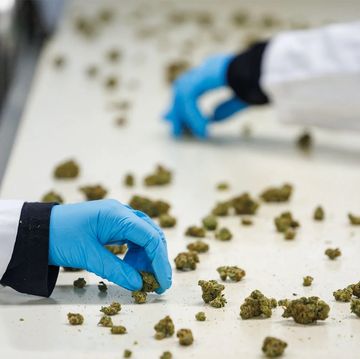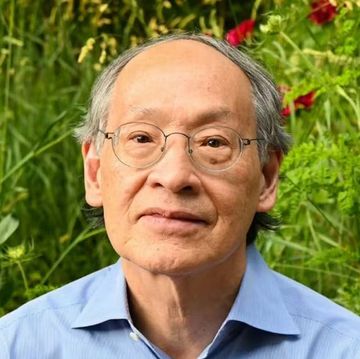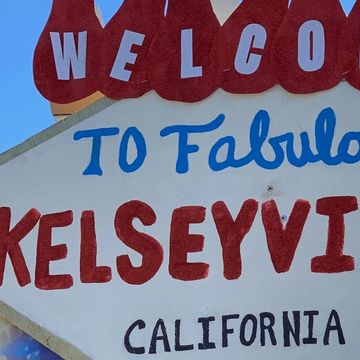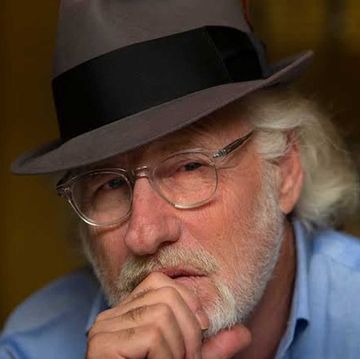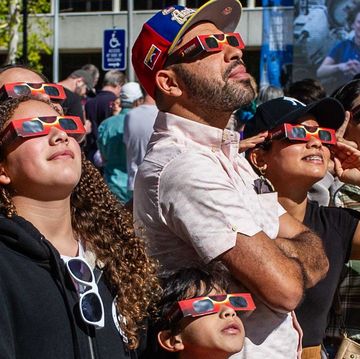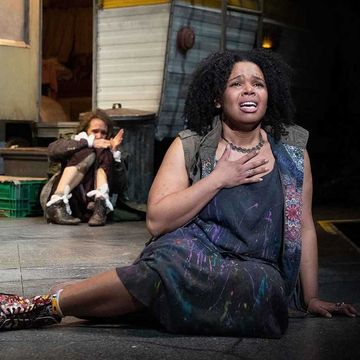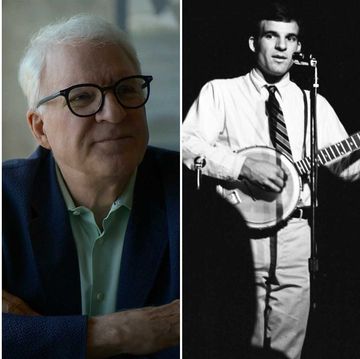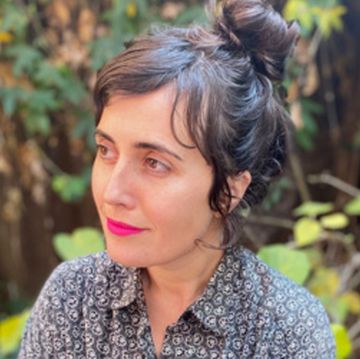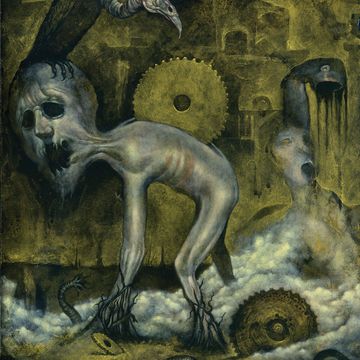This story is told from its end to a beginning. It’s about a remarkable tree now gone, but even more, it’s about a place also lost. Places that are lost are the most precisely located. They’re found in memory.
This article appears in Issue 24 of Alta Journal.
SUBSCRIBE
TODAY: ONLY APPROXIMATIONS
At N 34°03′10.6″ by W 118°13′58.2″—as precisely located as any place in Los Angeles—a bronze-colored commemorative plaque is set flush with the surface of the sidewalk where Commercial Street curves slightly northwest at Vignes Street near the eastern edge of downtown Los Angeles. The sidewalk is bordered by a vacant lot and a strip club.
A relief of a wide-spreading tree fills the top half of the plaque, but the plaque probably isn’t where that tree once grew. No coordinates fix that location. We only have approximations.
2019: SAGE AND SONG
It’s mid-April 2019, and Indigenous Angelenos (who choose to be known as the Kizh, pronounced “Keech”) gather on the sidewalk along Commercial Street. Ernie P. Teutimez Salas, chief of the Kizh, and his daughter Nadine have arrived, along with officials from the city, to dedicate the plaque. Sage is burned in the bowl of an abalone shell to mark the spiritual significance of the event. Nadine leads tribal members in song. They smile and pose for a newspaper photo.
The plaque reads:
Kizh-Gabrieleño Sacred Sycamore Tree—Sha’Var
Here once stood the grandest of all sycamore (Sha’var) trees measuring 60 feet high with a canopy spreading 200 feet wide. The tree was given the Spanish name of El Aliso. The original inhabitants of this area, the Kizh (Keech) or Gabrieleño were known as the people of the willow houses. These indigenous people have occupied this land for over 12,000 years. Their once peaceful life was forever changed by the California Mission era.
Always important in their history was this tree which once served as a site of worship, gathering and prayer for the Kizh. Native leaders would travel from as far away as Yuma, Arizona to unite at this sacred site. This Koo-nas-gna, or sacred burial place, is home to many Kizh burials as it once stood at the center of one of the largest Kizh villages, Yangna, now known as Los Angeles.
While El Aliso is long gone, the shade it provided no longer available and the memory of the conversations under its branches long lost, its significance to the Kizh is not forgotten. While its physical presence is gone, the oral history handed down through the generations has kept its beauty and story alive in the Kizh people.
Chief Ernie P. Teutimez Salas, April 2019
This plaque is dedicated by the City of Los Angeles to the original native inhabitants of this area, the Kizh—many of whom are still alive today.
While sage smoke and song rise into the overcast sky, the 101 freeway rumbles and whines nearby. El Aliso may have stood nearer the freeway’s edge. It may have stood where an on-ramp swoops onto the 101. It may have been even farther from its commemorative plaque—in the space occupied by the median of the 101.
If it’s important to stand at the exact place that held a sycamore that the Kizh called sacred, you’ll probably have to avoid cars getting on the freeway. Or you’ll have to drive by on the 101. In Los Angeles, pilgrimages require a car, or pilgrims are required to dodge them.
2017: Not all is gone
El Aliso is gone, but those it once sheltered are not lost. In 2017, the Los Angeles Department of Transportation opens up a stretch of Commercial Street to install underground cables and uncovers the burial of an Indigenous family. The Kizh welcome their ancestors but choose to reinter them where they were found. Something of El Aliso itself may remain. Something may have escaped the dissolution of Yaangna (a different spelling of Yangna) and be present beneath today’s concrete and asphalt. In life, the tree was deep-rooted, tough, and hard-grained.
1985: Another vacant lot
The 101 freeway crosses the Los Angeles River and bends around a high retaining wall. Behind are the ruins of brick and concrete buildings that homeless Angelenos have sheltered in for the past 13 years. They will be gone soon. The buildings—once a famous brewery—are becoming another vacant lot.
1955: If you drink it cold enough
Before the plaque on Commercial Street—before the vacant lot or the strip club—there is the original, narrower 101 freeway angling west into the center of the city. Behind the aggressive, chrome-toothed grilles of mid-1950s Buicks and Hudsons, drivers come out of the near darkness of an overpass into dazzling light and merging traffic that bends around the retaining wall of the Maier Brewery.
Drivers on the 101 can’t miss the brewery. Its Brew 102 sign is the first thing they see coming west, the last thing they see heading east. Of Brew 102, an old-timer remembers, “If you drank it cold, it tasted like beer.” The company turns out 370,000 barrels a year, according to the Los Angeles Times.
The bulk of the brewery is gone from view in moments from a driver’s perspective; the Brew 102 sign flashes by even sooner. If El Aliso were still in leaf, it would be far less conspicuous than the -neon-lighted sign.
1932: Counting rings
Landscape architect Charles Gibbs Adams shares his boyhood reminiscences in the pages of the journal of the Historical Society of Southern California. He makes a point of recalling the day in 1895 when El Aliso, surrounded on three sides by the Maier & Zobelein Brewery, was reduced to firewood and a stump.
Even at 10 years old, Adams knows enough to count the rings of annual growth to estimate how old the tree was. El Aliso, he writes, was “four hundred years of age.”
1907: Something is missing
The sign for the Maier & Zobelein Brewery has been painted over. Joseph Maier’s sons and George Zobelein have dissolved the partnership that made their brewery one of California’s largest. Now workers are painting a new sign for the Maier Brewery, naming the family solely in charge.
The brewery’s facade fills an entire block on Aliso Street except for a deep, empty notch near the corner of Aliso and Vignes Streets, as if something is missing.
1895: Death blows
Twelve years after forming their partnership, Joseph Maier and George Zobelein have a booming business, quenching the thirst of a population that doubles every decade. The Maier & Zobelein Brewery takes up an imposing block of multistory brick buildings on Aliso Street. The notch near the corner of Aliso and Vignes is shown in the company’s advertising, but the space isn’t empty. A tall, spreading sycamore nearly fills it.
For years, Maier and Zobelein have argued over what is to be done about this tree. Maier wants it cut down so the brewery can expand, so that there can be more beer. Zobelein wants the tree kept, perhaps only out of nostalgia. There have been bitter words between the two men.
In reality, the tree is thriving only in the brewery’s advertising. Aliso Street, paved with granite blocks, sheds rain away from the tree’s roots. The sycamore’s lower limbs have been pruned to let a teamster on the high seat of a beer dray pass under. The limbs above have been cut back to stumps because they reached the upper stories of the brewery buildings. In reality, El Aliso is dying or already dead.
In August 1895, Maier wins the argument, and the Los Angeles Times sends a reporter to watch “perhaps the oldest tree in Southern California” as it’s cut down.
All that is left of the once mighty giant of the plain, a gnarled and mutilated trunk, now lies prostrate on the ground. “Woodman, spare that tree.”… Such, in substance, has been the injunction of Mr. Zobelein, one of the proprietors of the brewery for a decade past, but at last the exigencies of business have won even his reluctant consent to have the old landmark removed. Mr. Maier, his partner, who is less sentimental, had for some years urged the felling of the old giant, as the spot occupied by it was needed as a building site, but Mr. Zobelein demurred.… “That tree has cost us already about $8000,” said Mr. Maier yesterday, “all on account of Mr. Zobelein’s sentiment, but even he had to consent to its removal at last. We all feel sorry, but it’s got to go because we need the room.”
The tree stands more than 60 feet high, its trunk 7 feet thick, when William Willoughby’s axe first bites into El Aliso. The trunk is found to be hollow, “the cavity being at least large enough to admit the body of a man,” the Times reports. As the chips fall from axe blows, the wood shows “evidences of having been charred, fires evidently having swept around the tree at various times.”
Felling the tree goes slowly. Frank Rademacher, chief engineer of the brewery, takes a turn with the axe, as do Joseph Maier and even the reporter from the Times. “Mr. Zobelein has felt too mournful over the fate of his old pet to strike any of its death blows,” the reporter writes. “Many old residents, especially Mexicans and Basques,” collect chips to keep as mementos. Perhaps some of the Kizh, who revere the tree, slip among the souvenir hunters to take away something of the sacred.
The Kizh never left Los Angeles, even after being pushed into the white city’s background and given the misleading name Gabrieleños, which associates them with the tragedies of the mission system. The Kizh are surely there at the brewery in 1895, unrecognized among the other laborers who load beer drays, stack the sacks of barley and hops, and muck out the stables.
1882: Lofty branches
Maier and Zobelein mark the expansion of their business with a color lithograph that shows the brewery’s two- and three-story brick buildings and the open yard that fronts the brewery on Aliso Street. A tree rises in the yard, tall and already thick-waisted. The Los Angeles Star names it “the big tree of Los Angeles.” It’s been called “el aliso” (meaning, confusingly, “the alder”) since Europeans settled in the wide valley of a river they called the Porciúncula.
For regularity and symmetry it has no equal in all the country around, and its graceful branches spreading across a diameter of nearly two hundred feet, afford a shade unlike any other in all Southern California.… Four feet from the ground the trunk measures twenty feet in circumference, exclusive of the bark, which is two inches in thickness.… The oldest residents here remember this tree as it stood fifty years ago, and assert that it was as large then as now.
Several years later in the Los Angeles Times, Stephen C. Foster, the city’s first American mayor, says the tree is 400 years old.
1879: Independence Day
July 4th celebrations are held under the tree’s branches. Sheep and bullocks are barbecued. There is beer, of course. The whole town is invited. Men wear woolen suits, vests, and dark hats. Women wear voluminous, mid-Victorian day dresses with layers of cotton over petticoats. The shade of the sprawling sycamore offers relief from the sun.
1860: An early photograph
An anonymous photographer climbs up the slope of the hill that rises behind the plaza, assembles the wood and brass furniture of his view camera, and ducks under a heavy cloth shroud. He’d already poured semiliquid chemicals onto the glass plate he’s holding. The prepared plate slides into the holder, and the camera’s lens cap is removed. The photographer counts out the seconds it will take to expose the image.
When the photograph is developed, the plaza and its few buildings are in the foreground. In the distance is the famous Sainsevain vineyard. El Aliso towers over the vineyard’s low-slung buildings. In the first known photograph of Los Angeles, the tree is a mass of black.
1858: Rows of vines
Freight wagons ford the usually narrow Los Angeles River by following ruts as they angle up the bank toward a landmark—“El Aliso”—conspicuous since it stands alone above rows of grapevines that extend from the river to nearly the center of a city numbering only 4,400 residents.
Around the tree are rows of vines tended by the brothers Pierre and Jean-Louis Sainsevain, who bought the business from their uncle, winemaker Jean-Louis Vignes. El Aliso’s canopy shades their warehouse, wine vats, distillery, and cooperage shop. Thirsty travelers inclined to stop often do. Those of a romantic turn of mind think the tree reaches out to shelter the vintage.
The Sainsevain brothers are proud of their “Pure Native California Wine…from their celebrated Vineyard of ‘El Aliso’ at Los Angeles.” The tree has become a brand.
In the vineyard, Indigenous workers, some of them doubtless Kizh, plant vines and trellis them with willow canes, harvest and press the grapes, and do all the manual labor of a business that produces nearly 150,000 bottles of wine and brandy a year to be sold as far away as San Francisco.
1856: The business of alcohol
Alcohol is the business of Los Angeles in tens of thousands of gallons a year. The city has an estimated 400,000 grapevines. Alcohol keeps the business going. Indigenous laborers are paid in the raw alcohol (aguardiente) that the Sainsevain brothers and other growers distill from their wine.
“Every Saturday evening they received their pay,” writes Harris Newmark, who chronicles Los Angeles in the 1850s. “During Saturday night and all day Sunday, they drank themselves into hilarity and intoxication, and this dissipation lasted until Sunday night. Then they slept off their sprees and were ready to work Monday morning.”
Labor for liquor is serial slavery for the Kizh. The town constable arrests drunken workers at sundown on Sunday and herds them into a corral at the top of Aliso Street in the Calle de los Negros. There, they’re fined one or two dollars they don’t have. The Act for the Government and Protection of Indians (California Statutes, chapter 133, April 22, 1850) allows “any white man” to purchase Indigenous labor for the cost of the fine. On Monday morning, vineyard overseers pay the fines and exact a week of work until Saturday afternoon. A half gallon of aguardiente begins the cycle again.
Horace Bell, another Los Angeles memoirist of the 1850s, thinks that those caught up in this brutal system die after two or three years of it.
1849: Yaangna is missing
El Aliso stood among the vines of Jean-Louis Vignes when Los Angeles became American in 1848. The Kizh community of Yaangna that had regarded the tree as a symbol of its continuity was already gone.
Yaangna had become a rancheria (or Indigenous settlement) by 1830. The Mexican authorities called it the Ranchería de los Poblanos. It was actually a work camp. Those who struggled to live there were Kizh who had never been processed by the mission system, former Gabrieleño neophytes uprooted when the mission system ended in 1834, and refugees from more distant villages. In the aftermath of the Americanization of Los Angeles, those living in that final remnant of Yaangna were forcibly scattered, some to the town, others to the outlying ranchos.
On the 1849 map of Los Angeles, vineyards and orchards cover the west bank of the Los Angeles River. Nothing of the Ranchería de los Poblanos or the Yaangna of Kizh memory is there. Some vineyard buildings are shown on the south side of a wagon track that comes up from the river, what is called the Old Aliso Road. Among the buildings is the suggestion of a spreading tree.
1833: Indigenous labor
Jean-Louis Vignes, uncle of the Sainsevain brothers, arrived in Los Angeles in 1831 and led the chain of immigrant winemakers who came to Los Angeles from the French Gironde. By 1833, nearly all the land that was within the boundaries of Yaangna has been acquired by settlers like Vignes, who are the “gente de razón,” the people who are not Kizh.
The rancheria is near today’s Fletcher Bowron Square, a half mile northwest of the El Aliso plaque. The plaza of Los Angeles is a short distance farther north. The plaza and the rancheria are side by side because the gente de razón depend on Kizh labor to dig and carry, to plait baskets and tan hides, to reap and mill the grain.
Vignes drafts gangs of laborers from the rancheria to plant 35 acres of vines along the Old Aliso Road. Vignes acquired the land and paid, some sources say, a $20 fee for the tree that towers over his squat adobe winepress. “Acquired” is a good word when facts are missing.
1818: The largest tree
The tall sycamore stands prominently on the bank of the Los Angeles River when Pío Pico, a future governor of Mexican California, arrives in the pueblo of Los Angeles. “The road then passed by it, and under its shade was the favorite camping place for travelers,” Pico will tell former mayor Stephen C. Foster in a memoir Foster writes for the Evening Express in 1877. “The valley from Aliso street south was then covered with a dense growth of sycamore, willow, poplar, and wild grape vines, and the little corn fields and gardens of the residents were mostly to the north of Aliso street. It was the largest tree then in the valley.”
1785: Unstable point of contact
Before Los Angeles was founded in 1781, the wide valley of an inconstant river was a whole world through which the Kizh moved in rhythm with the seasons, with the times of the acorn harvest and rabbit hunt, with the promptings of their visions and their sacred stories.
Center a map where North Broadway crosses the river and swing an arc east to Lincoln Park in Lincoln Heights, north to the Elysian Reservoir, west to the junction of the 5 and 110 freeways, and south to the intersection of Vignes and Commercial Streets, to where a tall sycamore once stood among the trees in a gallery forest along the river. The Yaangna of Kizh memory was in this circle before its land changed into something settlers could simply take.
At the unstable point of contact between settlers and the Kizh, there is one constant. Foster, in his 1877 memoir for the Evening Express, remembers a long-ago conversation with an early Angeleno. “I first saw Los Angeles in 1785, a boy of ten years of age, four years after the town was settled,” the old man tells Foster. Like Pío Pico, he remembers a tree with a massive trunk. “It was a large tree then, and I climbed its tall branches to rob the mocking bird of its young. When the Spaniards first saw Los Angeles there was a village of Indians here, afterwards called the Poblanos. Among them were men older than I am now…and they said the tree was there as long back as they could recollect.”
A memorable tree grows in Yaangna even if the willow houses of Yaangna don’t always stand around it.
1485: The conquistador
Sapling sycamores bud new leaves near the bank of a river that wanders from year to year. California sycamores favor floodplains like this one and take root near the boundary of flowing or pooling water.
The Kizh favor these watery, tree-shaded places too, as they have for thousands of years, as they did in assembling houses made from willow canes and reeds of a community named something like Yaangna (or Yangna, Yaanga, Iyáanga, or Yabit).
Across the ocean in the kingdom of Castile, Martin Cortés de Monroy, an infantry captain, and his wife, Catalina, welcome a new son into the world. They name him Hernándo.
In 35 years, Hernándo Cortés, as a Spanish conquistador, will propel the eventual destruction of Yaangna and nearly everything the Kizh call sacred.
1485: Tovaangar
Tovaangar. “The word is hard to pronounce,” Tom Curwen writes in 2019 in “Finding Tovaangar,” his account in the Los Angeles Times of students learning to speak the language of the Kizh. “Three syllables, the accent falling on the second and the ng pronounced as in singer, not finger. To-VAA-ngar. Literally, it means the world.”
In tovaangar, in the year Cortés is born, things have their true name.1 Hummingbird is piinor. Hawk is weeshenat. Coyote is 'iitara. The jackrabbit it hunts is shu'iit. The jackrabbit hides in the tall grass that is mamaahar and under the wild rose that is 'ochuur. When tovaangar is unbroken, no part of the world goes missing.
Tovaangar’s arroyos and plains hold about 100 communities. Yaangna, which may mean “poison oak place,” is a community of 200 or 300 and probably the largest in tovaangar. It’s on a shelf of land that slopes down to a river (although not precisely the river we have now) or maybe where Los Angeles City Hall is located today or farther northeast, where Elysian Park Drive meets North Broadway.
There are willow thickets near these places. Willow branches are gathered to bend into the frames of beehive-shaped houses. There are reeds by the river to plait around the frames to keep out the winter rain. There are laurels and sumacs for medicine, cottonwoods for firewood, and sycamores for timber, tools, and the hunter’s weapons. A sapling—the plaque’s El Aliso—spreads its branches.
Before years are numbered
Sometime in a year before years are numbered, a tufted seed of a sycamore—an unusually hardy parent, it will turn out—drifts above a stretch of riverside recently stripped of competing vegetation by a winter flood. The seed settles in a gash in the drying soil, but not too deeply.
Warmth reaches it in the following days. The last rain of the year waters it. The seed germinates.
2022: In memory yet green
At the corner of Cesar E. Chavez Avenue and Vignes Street, about 1,400 feet northwest of the El Aliso plaque, near the stub of Lyon Street (all that remains of the Old Aliso Road), is the Division 13 Bus Maintenance and Operations Facility of Metro, the regional transit agency. Suspended at the corner of the facility is a cube of translucent polycarbonate panels. On the panels that face the street—in shades of gray in daylight, black when illuminated from within at night—is an illustration of a tree. Its roots are knotted in the soil. Its trunk is mottled and gnarled. The artwork is El Aliso de Los Angeles by the German-born Christine Ulke, installed in 2016.
The El Aliso plaque set in the sidewalk on Commercial Street, the artwork at the bus maintenance facility, and this back-to-front account only approximate what the people of Yaangna knew and what I think their Kizh descendants want Angelenos to remember with them: This place is us. We are this place.
To remember El Aliso is to be at a beginning, and in the place where a tall sycamore is coming into bright green leaf again.•
Author’s note: The use of “Kizh” to refer to the original and still present Indigenous communities of Los Angeles—whose members name themselves Kizh, Tongva, Gabrieleños, Luiseños, and Mission Indians—does not imply that Kizh is the correct name. Kizh is the name used on the El Aliso plaque, and it is used here for consistency. The Kizh words in this essay are used with respect to those to whom this language belongs.
1The translations in this section are from the “Tongva Language” pages moderated by Pamela Munro, a professor of linguistics emerita who posts words and phrases in Tongva (her preferred name for the Indigenous language of the Los Angeles region) at facebook.com/tongvalanguage.
DJ Waldie’s most recent book is Becoming Los Angeles: Myth, Memory, and a Sense of Place.





